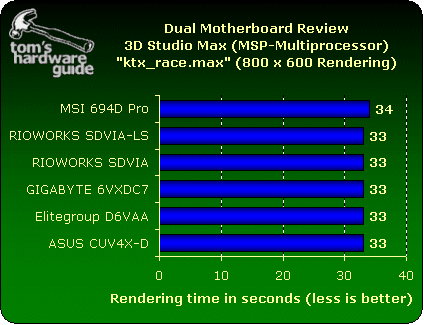Muscle-Flexing: 6 Dual CPU Boards
Benchmark Results And Discussion
All the boards we tested came furnished with two Pentium III/1000 processors, which were then supplemented with 256 MB of fast RAM at 133 MHz (CL2) and a sinfully expensive Quadro Pro graphics card from Nvidia (around $750). Let it be said, however, that the advantage in speed of the second CPU only comes into play when running selected applications such as rendering under 3D Studio Max or Cinema 4D. Otherwise, using a dual processor system for "everyday" purposes makes less of a difference than you might expect. Although the results of the Sysmark 2000 show slightly higher results on dual boards, the attained increase in speed is less than 10 percent. The 3D games benchmark also shows how much of an increase in performance can be brought about by a second processor.
Rendering Performance: 3D Studio Max R3


During rendering in 3D Studio Max, the second CPU on all the boards was pushed to its limit. The time to calculate the scene ktx_race.max was slashed in half by the second CPU. A direct comparison of all the boards reveals that, in single mode, the Elitegroup D6VAA is the best while the Asus CUV4X-D takes the cake in dual mode.
Stay on the Cutting Edge
Join the experts who read Tom's Hardware for the inside track on enthusiast PC tech news — and have for over 25 years. We'll send breaking news and in-depth reviews of CPUs, GPUs, AI, maker hardware and more straight to your inbox.
Current page: Benchmark Results And Discussion
Prev Page Test Configuration Next Page Animation And Rendering: Cinema 4D XL 6.0Most Popular

